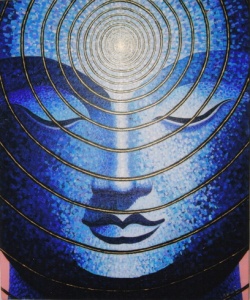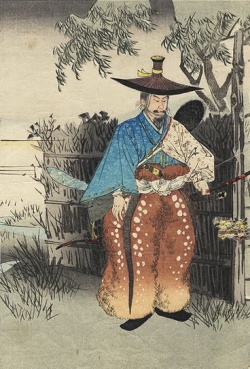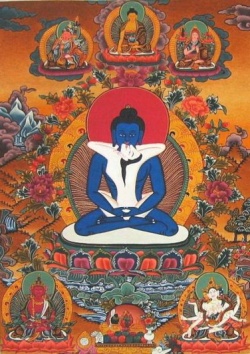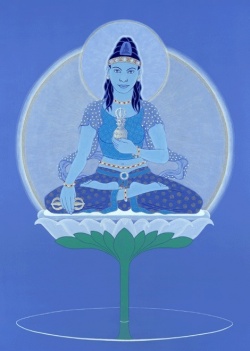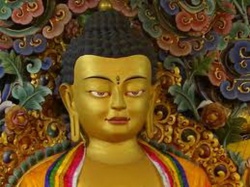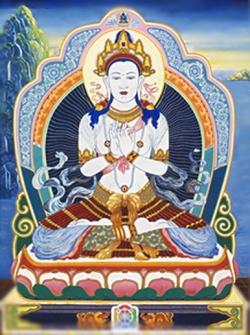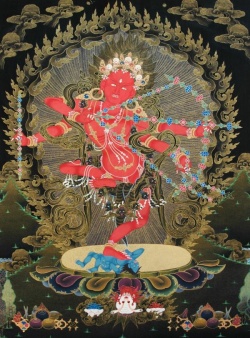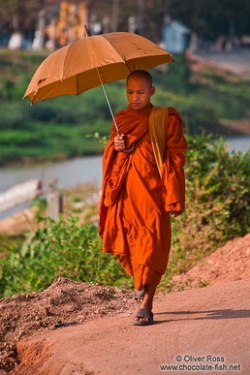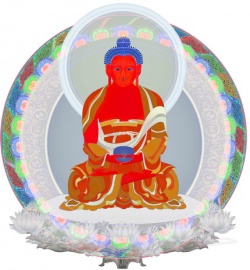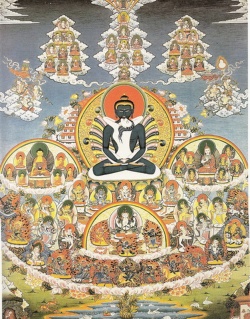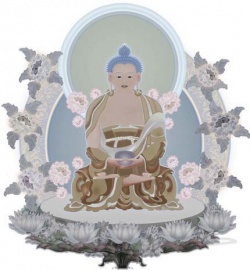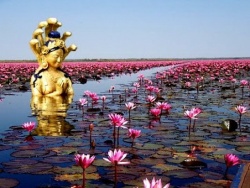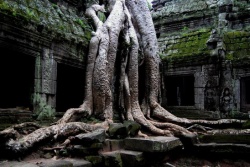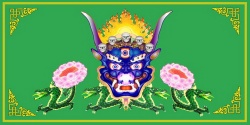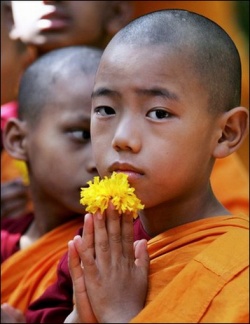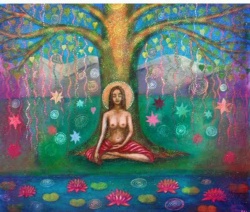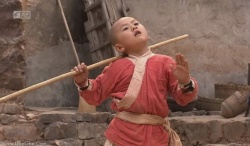The Korean Buddhist Canon: A Descriptive Catalogue, by Lancaster and Park
I. Preface
In the 1960s the monks at Haein Monastery in South Korea undertook the task of making twelve sets of xylographs from the blocks preserved in their buildings. One of these sets was acquired by Dr. Elizabeth Huff, then the Head Librarian of the East Asiatic Library of the University of California at Berkeley. When the more than 1400 volumes had finally all arrived at the Library, it was obvious that the collection would be difficult to use because there were few reference aids and those were mainly listings of titles in sequential order with no connection to the bound volumes. Recognizing the value of such material for scholars, a request was made to the Center for Japanese and Korean Studies at the University for funds to provide for research assistance in the task of cataloging it. Mr. Ronald Epstein, then a graduate student in the University, was the first of the assistants and undertook the examination of the volumes for information contained within them as well as checking the completeness of the set held by the Library. Later, Mr. Sung-bae Park joined the newly established Group in Buddhist Studies as a graduate student and became a research assistant on a second grant from the Center. By 1974 the catalogue had grown from its beginning as an aid to finding titles within the volumes to a more comprehensive description of each work. Mr. Park became a partner in the project and with a group of new assistants the expansion of the scope of the catalogue was undertaken. Ms. Janet Gyatso, a graduate student in the Group in Buddhist Studies, Mr. Kenneth Eastman from the Oriental Languages Department, Ms. Sheila Regan, graduate student in the Group in Asian Studies, Mr. Kurt Schwalbe from the Graduate Theological Union, Mr. Brian Galloway and K. Douglass provided the necessary help for the final stage of compilation and the detailed and often tedious tasks of rechecking the previous work. A number of typists have transferred the information from work cards into manuscript form. Most notable among these have been Mr. Robin Yates and Ms. Katrina McCleod, graduate students in the Department of Oriental Languages. Their careful attention to the details of the content was an essential part of the preparation. Others who have helped at some stage in the project have been Mr. David Schneider, Ms. Mary Brown, Ms. Carolyn Yoshimura, Ms. Beth Upton, Mr. C.S. Kim, Mr. B.K. Woo, and Mr. Carl Bielefeldt.
Without the support of the Center for Japanese and Korean Studies, the work could hardly have been begun, much less have assumed the final form. The Directors, Professors Robert Bellah and Thomas Smith, have during their tenures been supportive and helpful at every step, and Ms. Julia Cleland, the Administrative Assistant, always a willing helper with the details of grants and student assistants. Throughout, Mr. Raymond Tang, now the Head Librarian of the East Asiatic Library, Mr. Charles Hamilton, Chief Cataloguer, and Mr. Y.K. Choo, the Korean Cataloguer, have given all possible assistance.
As the catalogue neared completion, the welcome news came that Dongguk University was publishing a complete set of the material in photo-reprint. Under the direction of President S.K. Lee, that University has made available in 47 volumes the facsimiles of the xylographs made directly from the blocks. In addition Prof. K.Y. Rhi and staff compiled a comprehensive catalogue in Korean, which is vol. 48 of the newly published set. It was a fitting project that a Buddhist University in Korea marked its 70th Anniversary with a new version of the canon.
LEWIS R. LANCASTER
Department of Oriental Languages
University of California, Berkeley
II. Introduction
Some three centuries after Buddhism was known to have reached China, there is literary evidence of its presence in the Korean peninsula. The traditional date for the arrival of Buddhism in Korea is A.D. 372;1 however, there was a communication by letter between Chih Tao-lin (A.D. 314-366), an eminent monk of the Eastern Chin dynasty, with an unidentified monk in Korea.2 Since Chih Tao-lin had died prior to the traditional date of introduction, one can assume that the Buddhist monks were already there before A.D. 366.3 On the other hand, considering how powerful Buddhism had become in China by the middle of the fourth century and how important Chinese thought and institutions were to the Koreans, it is difficult to believe that the first encounter with Chinese Buddhism came so late in the century.
Throughout its history, the dissemination of Buddhist teachings has been closely tied to the scriptures and the translations of the many texts which constitute it. As the centuries passed for the Chinese Buddhists, hundreds of texts were translated from Sanskrit into Chinese and in addition there developed a sizable corpus of literature composed of the writings of learned and inspired monks and nuns within China. From this extended collection of material, there occurred a steady influx of documents into the growing community of Korean Buddhists from the fourth century onwards. There is no complete record of this introduction of Buddhist literature, but a few major landmarks help us to see the quantity of writings which were being brought into the states established in the Korean peninsula. In the sixth century a Paekche monk came back from India with a teacher as his companion, and they brought Sanskrit texts, especially focusing on those belonging to the Vinaya (rules of conduct for the monastic community) and Abhidharma (philosophical and commentarial literature).4 Liu Ssu, an envoy from the Ch'en court, and Shih Ming-kuan arrived in Korea in A.D. 565, bringing with them a complete set of the canon in 1700 chüan. This is the earliest recorded date for the availability of the whole of the Chinese Buddhist translations in Korea.5 Since the printing blocks of the sort so famous in later centuries were not yet in use, this material was in the form of manuscripts. Requiring the efforts of many scribes, complete sets of the canon were by no means common and it was not until A.D. 928 that the histories record the arrival of another collection of the scriptures.6
During the tenth century, the Chinese began to carve the entire canon onto wooden printing blocks from which large numbers of xylograph prints could be taken. This first carving in China is said to have lasted from A.D. 971 to 983.7 Thus after a period of carving that lasted for twelve years, the Chinese version of the Buddhist canon became available in the printed form and was known as the Shu-pen (蜀本) or Szechuan edition of the Sung dynasty. When the Koreans heard of the existence of this remarkable new set of texts, the King of Koryŏ sent an official request for a copy of the edition and two years later the records tell us that it arrived (A.D. 991).8
Even when a set of blocks had been carved for printing the scriptures of the Buddhists, they could not provide complete coverage of a canon that was constantly being enlarged through the arrival of new texts from India. The catalogues made by the Chinese monks provide some glimpse of the increasing number of texts that were available. One catalogue in A.D. 730 mentions 5,048 chüan9 another in A.D. 799 records 5,39010 and in A.D. 1027 the number had reached 6,197.11 Thus even when the Sung edition had been carved there were always other texts still waiting to be collected, translated and carved on blocks. In consequence Buddhist texts continued to come from China into Korea in what must have appeared as a never-ending flow of riches. For example, in A.D. 1021 another set of the canon arrived and in A.D. 1022 the Prajñāpāramitā texts translated by the famous Hsüan-tsang were shipped to Korea.12 These latter texts were quite famous because the lettering had been done with gold dust.
There were other events in the eleventh century which were not so happy for the relations between Korea and China. In A.D. 1010 the Liao forces invaded Korea,13 an example of the threats which were constantly harassing the people. The shock of this invasion was great and there was an upheaval at the royal court. When the troops of Sheng-tsung occupied the capital city, King Hyŏnjong and his attendants sought refuge in the southern part of the country. In the face of this strong and ruthless enemy, we are told that the King turned to Buddhism for aid and made a solemn vow that if the invaders were removed from his country, he would have the entire Buddhist canon carved on printing blocks.14 After eleven days, the invaders did leave the capital and began a march northward.15 When life had resumed something of its normal course of activity, the King, true to his vow, commissioned the first complete set of Korean carvings of the Buddhist texts. Thus it has been said through the centuries that the carving of these blocks was done to protect the nation against invaders and disasters.
Revision of history is ever a popular activity and in the 1920s Prof. H. Ikeuchi, a Japanese historian, wrote a detailed account of the process of carving the canonic blocks.16 He was critical of the view that the blocks had served as a defense for the nation, maintaining instead that the story had been used to perpetuate a superstitious view of the project. He laid the blame for this alleged misrepresentation on Yi Kyu-bo, a member of the court who had offered a prayer during the ceremony for the second carving project.17 In that prayer, which has been preserved, it is stated that the first carving project had been done to protect the nation from invaders. Ikeuchi scoffed at this claim and maintained it to be a fabrication of Yi Kyu-bo and in no way factual. If the blocks had served such a purpose, then, Ikeuchi argued, they would have to have been completed in eleven days, the period during which the invaders stayed in the capital. Since no such herculean task was performed, he rejected the whole idea and stated that there was a very different reason behind the project. The King had been a patron of efforts to prepare printing blocks long before the invasion took place. This was not directly related to the safety of the nation but was inspired by his obsessive interest in the state of his parents' souls,18 especially since they had been executed for the crime of having a child before marriage. His first attempt to secure posthumous merit for them was the construction of Hyŏnhwa Monastery in their memory. Then, to raise the status of this new monastery, he had undertaken the additional task of having important sūtras carved on printing blocks.19 Since all of this happened before the invasion, Ikeuchi concluded that the carving was started and completed not as a project to protect the nation but as a means of giving merit and benefit to the king's deceased parents.20
While Ikeuchi's arguments are detailed and he has been one of the most thorough students of the literature related to the canonic blocks, some questions can be raised regarding his conclusions. Writing in the time when his own country was considered by most of the populace of Korea to be invaders, it was not surprising that he was sensitive to the story that the carvings had once served to defend against invasions. When one reads the prayer of Yi Kyu-bo, there is no indication that he thought the first carving was completed before the removal of the danger. Rather, it is implied that the vow was made by the King to have the carving completed and then the invaders left the capital.21 Therefore, one might say that the carving was done at a later time as a thank offering and as a fulfillment of the promise on the part of the King.
As Ikeuchi points out, there were carving efforts prior to the invasion. The number of texts which had been put on blocks was not large in relationship to the total number available because these earlier attempts had been limited to only the most important texts. But with the Shu-pen edition as a model, it is not surprising to find some activity of this kind being carried out in Korea. The initial impulse of King Hyŏnjong was very probably to give aid to his parents in their life after death. When the invasion jolted his kingdom, he then made the decision to have the complete canon preserved in this fashion. After the peace was agreed upon he made good his vow but also continued to include his prayers and wishes for the welfare of his parents. In other words, the initial impetus for the first carvings under the decree of the King was one of filial piety and this was present throughout the project. However, the impact of the national crisis must have been one of the main reasons for considering the larger and more ambitious project.22
Another possible reason for the carving suggested by the Korean historians is that of cultural interest.23 The carving and printing of the Buddhist canon was a feat worthy of the best that the Chinese could produce and so this work went forward as an outward show of the strength and culture of Koryo contrasted with the invaders, who appear as little more than pillagers.
Since the work of carving went on for more than forty years, we must assume that there was something beyond the danger of a particular invasion to prompt such an investment of time and skills. The existence of such a revered object in the nation must have been a source of pride and have encouraged the people to hope for better days with the power of their talisman. It may well have been that the news of the effectiveness of the blocks was spread to prospective invaders so as to give them pause, since many of them were also practicing Buddhists.
Thus, for what must have been a complex of reasons, the carving of the entire set of blocks was undertaken in the first quarter of the eleventh century and continued for several decades. Dr. N.C. Paik, a modern Korean scholar, holds to the date of A.D. 1010 for the starting of the set, but feels that there is no clear evidence for designating the date of completion.24 Considering the constant increase in the size of the canon, it is possible that the period of carving was extended as newer texts were brought in and added to the collection.
Using the Shu-pen as the basis for the blocks, the Koreans depended on the oldest xylograph collection. In the eleventh century they were the recipients of the Liao dynasty edition, which was brought in A.D. 1063.25 In A.D. 1083 the last complete edition of the Chinese Buddhist canon came to Korea, also based on the old Shu-pen edition but including a number of new translations.26
When the canonic material was finally available through the imprint from these blocks, a different but extremely important task was begun by one of the famous monks of that period. Ŭich'ŏn, a younger son of King Munjong, became a monk at the age of eleven and remained in the monastic life until his death at age 47.27 He was a monk with great facility in scholarship and possessed the inclinations of a collector and librarian. So strong was his determination to have copies of the entire corpus of Buddhist literature, including commentaries and writings by his contemporaries all over East Asia, that he made a trip to China even though the King was in opposition to such a journey. Staying in China for nearly a year, he managed to collect an impressive array of texts and returned to Korea with more than 3,000 chüan.28 He dispatched buyers and collectors to Japan and other parts of China and as a result brought together what he termed an "extension" of the canon, that is the acceptance of texts written by East Asian Buddhists as a part of the canon. In A.D. 1090 he published his famous catalogue of this collection with reference to 1,010 titles in 4,740 chüan29 In recognition of the importance of these texts, blocks were carved for each of them. When this supplementary extension of the canonic blocks was completed, it marked a major new development in the treatment of Buddhist texts, since these East Asian writings were given the highest possible status. It may well be that Ŭich'ŏn's greatest contribution went beyond his role as a collector and is found in the fact that he considered this literature as worthy of notice and due a place alongside the translations from India.
There is one aspect of Ŭich'ŏn's work that has been criticized by later scholars. For some reason he decided not to collect any of the material belonging to the Ch'an (sŏn) school but limited his efforts to the textual (kyo) schools. Why, ask the historians, did he show such bias against the works of the meditation school? There is no direct answer from Ŭich'ŏn's own writings and we must accept the fact that he indicates in the very title of the catalogue that he is limiting his efforts to one aspect of the literature.30
As a result of all these efforts, by the end of the eleventh century Korea possessed one of the most complete and comprehensive libraries of Buddhist texts. Not only did they have copies of these materials but they were able to make xylograph copies for distribution.
Unfortunately, new troubles arose for the peninsula and its people.
In A.D. 1231 the Mongols invaded and by A.D. 1232 the King and his court had to take refuge on Kanghwa Island.31 The blocks of the canon and the supplementary extension gathered by Uich'on were housed in the Puin Monastery near Taegu. During the winter after the court had removed from the capital, the invaders took charge of the monastery and in an act of wanton destruction burned the entire set of blocks.32 This may have been in part aimed at convincing the Koreans that they no longer had a sacred protector and it might even have made the invading Mongols feel safer to know that the blocks were no longer in existence. Hearing of the loss of the blocks, the King made a vow similar to that of King Hyŏnjŏng and plans were made again to put the entire canon on printing blocks. Four years after the fires at Puin Monastery, the work was once again underway to carve a second set of printing blocks. The work went on for fifteen years from A.D. 1236-1251.33 King Kojong in his 38th year of rule gathered with his subjects at the great hall outside the western gate of the Kanghwa capital for a commemoration ceremony.34 It was here that the prayer of Yi Kyu-bo was given which made reference to the events related to the first carving.
This second project was not a recopy of the former version but was an editorial venture as well. Using the larger and newer Liao edition along with the older Shu-pen one, a board of scholars under the guidance of Sugi prepared editions for the carving.35 In the process of preparing the list of texts to be placed on the blocks Sugi and his board turned away from the procedure that had been followed by Ŭich'ŏn. It had been Ŭich'ŏn who had seen the importance of the non-Indian commentaries and writings and who had mourned the fact that they were excluded from the canon. He had feared that many of these works would vanish due to a lack of any systematic preservation scheme. When he had gathered as much of this material as possible and had seen it put on printing blocks, he rejoiced that these writings by the learned monks of East Asia would now be preserved with vigor equal to that normally reserved for the translations from Sanskrit. However, when Sugi undertook the task of collecting and editing the texts for the second set of carvings, he ignored the catalogue of Ŭich'ŏn and turned to the traditional catalogues of China. Relying mainly on the K'ai yüan lu36 he omitted the supplementary additions of Ŭich'ŏn. Just as Ŭich'ŏn feared, many of the texts which he had collected are no longer extant.
Part of the work on the second set of blocks took place on Kanghwa Island and some of it was done near Chinju. The project was a large one, for there were 1,512 titles to be included comprising 6,791 chüan. The editing work was a masterful job of scholarly effort and in the second set of blocks the Koreans once again provided the major part of Buddhist texts, to be found in Chinese, in a readily available form. When finally edited, corrected and carved, the set of blocks numbered 81,258 plates. Each was carved on both sides with twenty-three lines of fourteen characters each. The calligraphy was excellent and the layout such that all the characters appeared in large size. The blocks measured two feet three inches in length and nearly ten inches in width and more than an inch in thickness. A very hard and durable wood from the Betula schidtii regal tree (known as Paktal in Korean), gathered on the islands off the coast, was used.
First stored at the gate of Kanghwa Palace, the blocks were later moved to Sŏnwŏn Monastery on the island and stayed there for over a hundred years.37 In A.D. 1398 the security of Kanghwa Island became questionable because of pirate raids and so the collection was moved to Chijung Monastery near Seoul.38 It is not known whether this was ever intended as a permanent home or was just an interim storage until the blocks could be placed in some safer area. Finally in A.D. 1399 the last move was started and the blocks were placed at Haein Monastery on Mount Kaya near Taegu.39 It is here that the monks have protected these blocks against fire and destruction up to the present day.
Xylographs from these blocks have played a major role in the modern editions of the Buddhist canon, serving as the basis for three versions of the canon published in Japan: Shukusatsu zōkyō, printed during the years of 1880-85,40 the Manji zōkyō, printed 1902-05,41 the Zoku zōkyō42 and the Taisho shinshū daizōkyō, 1924-34.43 Thus our present-day Buddhist studies owe a great debt to the past efforts of Korea, a debt which is for the most part unrecognized and consequently our study of Korean Buddhism is neglected.
For many years little was known about these blocks outside of Korea; and even within the country, during the Yi dynasty when Buddhism had been suppressed, there was a lack of attention from the court or government officials. At the beginning of this century some reports about the blocks began to appear in Japanese publications,44 the most detailed being those of Mr. Sekina, an architect.45 Today the collection is recognized by the government as well as the people of Korea as one of the priceless treasures and a heritage of the skill and expertise of the past. It is housed in two large buildings which are integrated into the monastic complex at Haein. The storage buildings are built so there is free circulation of air through open grilles and the blocks are racked in separate niches extending the whole length of the buildings and reaching from floor to ceiling. Recently a new ferro-concrete structure has been erected for the purpose of preserving the blocks, and they will no longer be found in their current location. In those instances where a block from the original set was found to be missing or damaged, new replacements were carved some fifty years ago. Visitors are allowed to see the blocks and Haein Monastery has become an important tourist attraction, while still maintaining its place as a major training center for Korean Buddhism.
It is to be hoped that this catalogue will allow scholars to make use of this version of the Buddhist canon and restore it to its rightful place as a primary source for the study of the Chinese Buddhist tradition as well as that of Korea.
III. Abbreviations
A. Anguttaranikaya
C- Cone Edition (Tibetan Buddhist Canon)
ch. chüan
Cv. Cullavagga
D. Dighanikāya
D- Sde-dge Edition (Tibetan Buddhist Canon)
Divy. Divyāvadāna
Edg. F. Edgerton, Buddhist Hybrid Sanskrit Dictionary
H. Han'gul taejanggyong kanhaeng mo
HDJK. Han'gul-dae-jang-kyong
Itiv. Itivuttaka
J. Jātaka
KDJK. Koryŏ-dae-jang-kyŏng
L- Lhasa Edition (Tibetan Buddhist Canon)
M. Majjhimanikāya
Mano. Manorathapūranī
Mv. Mahāvagga
Mvy. Mahāvyutpatti
N- Snar-thaṅ Edition (Tibetan Buddhist Canon)
Nj. B. Nanjio, A Catalogue of the Chinese Translations of the Buddhist Tripitaka.
O. A Comparative Analytical Catalogue of the Kanjur Division of the Tibetan Tripitaka (Ōtani University).
Ono. Ono Gemmyo, ed. Bussho kaisetsu daijiten.
P- Peking Edition (Tibetan Buddhist Canon)
S. Samyuttanikāya
Śiks. Śikṣasamuccaya
Snp. Suttanipātā
T. Taishō shinshū daizōkyō
Thera G. Theragāthā
Therī G. Therīgāthā
To. H. Ui, ed. A Complete Catalogue of the Tibetan Buddhist Canon (Tohoku University).
IV. Guide to the Use of the Catalogue
While this catalogue has been designed to provide information regarding the Haein Monastery xylograph collection, it can also be of use to scholars wishing information regarding the Sanskrit and Tibetan texts. It is the intent of the compilers to give enough data for each title so that the catalogue will serve as an independent reference work not requiring further access to library resources for identifications of texts.
The comparative and descriptive information appears in the following order:
.***K = the sequential number assigned to the texts as they occur in the volumes described above. In those cases where the catalogue contained in the set, the Taejang mongnok (大藏目録), indicates that the title is a secondary entry, lower case letters have been added to the K number rather than adding a new number.
.*** Volume = the Volume or volumes of the xylograph print of the Haein Monastery held by the East Asiatic Library of the University of California.
.*** (Roman numerals) = Volume and page for photo-reprint of the Haein xylographs published by Dongguk University (1976) in 48 volumes.
.*** T. = the matching number used in the Taishō shinshū daizōkyō edition.
.*** H. = the matching number used for the modern Korean translations recorded in the Han'gul taejanggyong kanhaeng mongnok. While this collection of the translations is far from complete, the projected numbers for future ones are included. In those cases where the translation publication is still pending the reference under (3) will contain the projected volume number without page reference following the entry HDJK.
.*** (Sanskrit Title) = the best known Sanskrit title for the text. When a published edition is available or extant manuscripts are known, the reference will appear under (5). When the text is missing in Sanskrit but the title appears in some source, then (5) provides an appropriate lexigraphical note. If there is no extant Sanskrit, but there is a Tibetan translation as indicated by (6), it can be assumed that the Sanskrit title has been taken from the introduction to those Tibetan translations. When neither Sanskrit (5) nor Tibetan (6) reference is available, the titles have been constructed from the Chinese translations. This latter category is used only when such constructed titles have been used in reference works. In many instances the Sanskrit title is not known and this entry is left open.
.*** (Names) = in those cases where authors of texts are known from the Chinese, Tibetan or Sanskrit, they appear following the title of the text.
.*** (Tibetan Title) = the Tibetan title for the text as recorded in the Sde-dge version of the canon.
.*** (Chinese Title) = romanized title for the Chinese characters following the Wade-Giles system.
.*** (Characters) = the Chinese character title as found on the plates of the Haein Monastery collection.
.*** (Han'gul Title) = the Han'gul equivalent pronunciations for the characters. The traditional Buddhist pronunciations have at times been employed so as to be in accord with the Han'gul translations listed under H. and (3) HDJK.
.*** Translation, etc. = information regarding the translation into Chinese. The translator names are given, whenever possible, in the Sanskrit form for non-Chinese. There is a cross reference provided in the "Author-Translator Index" between the Chinese form of the name and the one used in the catalogue entry. The dates are given for the translation, first by dynasty and reign years and then by conversion into Western calendar months and years. At the end of this section there is information regarding the monastery in which the translation took place or the region if known.
(1) = other versions of the same text to be found in the Haein Monastery collection.
[ * ] = the sequential number of a work appearing in a compilation containing a number of individual texts that may also appear as separate items.
[ ] = reference to chapters within a text.
( ) = reference to foreign lang="zh">chüan within a text.
(2) = information regarding the Haein Monastery blocks.
"case" = the characters used to divide the original set of blocks into units. Here the characters are those found in the well known "Thousand Character" scheme. Using these "case characters" it is possible to locate titles in any version of the Haein set.
"carved" = the year given for the carving of the blocks on which the text is to be found.
(3) = reference to other versions of the Korean canon and to its translations.
KDJK = the volume and pages in the Koryo-dae-jang-kyong, the photo-reprint edition of the Haein xylographs.
HDJK= the volume of the Hanguk-dae-jang-kyong, the modern translation into Korean. When the translation has not yet appeared the projected volume number appears without page reference. The sequential number for these translations appears under the entry H. above.
(4) = a comparative listing of references in other catalogues
Nj. = the listing of the number for the text in the Catalogue of the Chinese Translations of the Buddhist Tripitaka compiled by B. Nanjio.
Ono. = Volume and page reference for the Bussho kaisetsu daijiten prepared by G. Ono.
To. = the listing of the number for the text in the Complete Catalogue of the Tibetan Buddhist Canon edited by H. Ui and others at Tohoku University.
O. = the listing of the number for the text in the Comparative Analytical Catalogue of the Kanjur Division of the Tibetan Tripitaka at Ōtani University.
P. = the listing of the number for the text in the Tibetan Tripitaka, Peking Edition, edited by D.T. Suzuki. It should be noted that 0. and P.'numbers are identical since they both refer to the Peking Edition and in this section P. is not given when O. is available.
Mvy. = the listing of the number for the text in the Sanskrit-Chinese Dictionary of Buddhist Technical Terms based on the Mahāvyutpatti, edited by U. Woghihara.
(5) = Sanskrit information.
(a) Editor's name if there is a printed version, followed by the year of the edition. Since this catalogue is not intended as a bibliography, the full reference is not given but the "Bibliography of Buddhist Scriptures" by Edward Conze soon to be published is an easy source for the exact designation of these published versions. This entry is only intended to establish the existence of the Sanskrit in edited form or in extant manuscripts.
(b) When only the title of the Sanskrit is to be found, lexiographical data regarding its appearance is listed.
(c) Whenever there are alternate Sanskrit titles, they will be given under this heading.
(d) Tibetan information regarding the Sanskrit title may also appeal-under (5). It should be noted that such words as Ārya preceding the title or the expression nāmamahayānā before the word sūtra are omitted.
(6) = Tibetan information.
This entry establishes the existence of a Tibetan translation and provides a comparative table for five versions of the Tibetan canon, listing the section followed by the volume letter and folio numbers.
P- = Peking Edition
N- = Snar-thaṅ Edition
D- = Sde-dge Edition
L- = Lhasa Edition
C- = Cone Edition
Notes
1. Iryon, Samguk yusa (T.2039-986a:5).
2. Hui-chiao, Kao seng chuan (T.2059-348a:12).
3. Kim Yŏng-t'ae and U Chŏng-sang, Han'guk pulgyo sa (Seoul, 1970), p. 24.
4. Ibid. p. 30.
5. Samguk yusa (T.2039-994a:26).
6. Ibid., (T.2039-994b:17).
7. Tokiwa Daijō, "Daizōkyō chōinkō"Tetsugak zassi, 313 (March, 1913). Kenneth Ch'en, Buddhism in China (Princeton University Press, 1964), p. 375.
8. Koryŏ sa (Seoul: Tongbanghak yŏguso, 1955-1961), the record of the 8th year and 10th year of King Sŏngjong. Sung shih (Che-chiang shu-chü, 1875), see "Kao li chuan"chüan 487.
9. Chih-sheng, K'ai yüan shih chiao mu lu (T.2154-572b:13).
10. Yüan-chiao, Cheng yüan hsin ting shih chiao mu lu (T.2157-896c:13).
11. See Wei-ching's T'ien sheng shih chiao tsung lu, found in the Sung ts'ang i chen (Peking, 1935), vol. 112.
12. Koryŏ sa, the record of the 6th month, 12th year and the 5th month, 13th year of King Hyŏnjŏng . Ch'ae Ch'ung-sun, "Hyŏnhwasa pi ŭmgi"Chōsen kinseki sōran, vol. 1, no. 72.
13. Yi Ki-baek, Han'guk sa sin'gang (Seoul, 1967), p. 149.
14. Yi Kyu-bo, "Taejang kakp'an kunsin kigomun"Tongguk Yi Sangguk chip (Seoul, 1959), vol. 25.
15. Ikeuchi Hiroshi, "Kōraichō no daizōkyō"Mansenshi kinkyū chūseihen 2 (1937), p. 508.
16. Ibid., pp. 483-636.
17. Yi Kyu-bo, "Taejang kakp'an kunsin kigomun," vol. 25.
18. Ikeuchi Hiroshi, "Kōraichō no daizōkyō" p. 495.
19. Ibid., p. 512.
20. Ibid., p. 513.
21. Yi Kyu-bo, "Taejang kakp'an kunsin kigomun," p. 506.
22. William E. Henthorn, A History of Korea, (New York: The Free Press, 1971), pp. 96 ff.
23. Yi Ki-baek, Han'guk sa sin'gang, p. 148. Kim Yŏng-t'ae and U Chŏng-sang, Han'guk pulgyo sa, p. 124.
24. Nak-choon Paik, "Tripitaka Koreana,"Transactions of the Royal Asiatic Society, 32 (1951), pp. 62-73.
25. Kai-hyŏn Ahn, "Publication of Buddhist Scriptures in the Koryo Period,"Buddhist Culture in Korea. Korean Culture Series 3 (Seoul, 1974), p. 86.
26. Ikeuchi Hiroshi, "Kōraichō no daizōkyō," p. 497.
27. Cho Myŏng-gi, Koryō Taegak kuksa wa ch'ont'ae sasang (Seoul, 1964), pp. 7-28.
28. Ibid., p. 15.
29. Uich'ŏn, Sinp 'yŏn chejong kyojang ch'ongnok (T. 2184-1166a) Kim Yŏng-t'ae and U Chŏng-sang, Han'guk pulgyo sa, p. 108.
30. Oya Tokujō, Kōrai zokuzō chūzōkō (Kyoto, 1937) vol. 1, p. 35.
31. Kim Yŏng-t'ae and U Chŏng-sang, Han'guk pulgyo sa, pp. 124-25.
32. Ibid., p. 125.
33. Yi Kyu-bo, "Taejang kakp'an kunsin kigomun," vol. 25.
34. Koryŏ sa 24, the record of the 9th month, 38th year of King Ko-jong.
35. Sugi Koryŏguk sinjo taejang kyojŏng pyŏllok, (K. 1403).
36. Compare the K'ai yüan shih chiao mu lu (T. 2154) compiled by Chih-sheng with the Taejang mongnok compiled by Sugi (K. 1406).
37. Kim Sang-gi Koryŏ shidae sa (Seoul, 1961), p. 918.
38. Chosŏn wangjo sillok (Seoul: Kuksa p'yonch'an wiwonhoe, 1955) vol. 1, the record of the 5th month, 7th year of King Taejo.
39. Ibid., the 1st month, 1st year of King Chŏngjong.
40. Dainippon kōtei shukusatsu daizōkyō 418 vols. (Tokyo: Tōkyō shoin, 1880-1885).
41. Dainippon kōtei zōkyō 7082 vols (Kyoto: Zōkyō shoin, 1902-1905).
42. Dainippon zokuzōkyō 7140 vols. (Kyoto: Zōkyō shoin, 1905-1912).
43. Taishō shinshū daizōkyō 100 vols. (Tokyo, 1924-1934).
44. Sekino Sada "Kankoku kenchiku chōsa hōkoku"Tokyo teikoku daikaku koka gakujutsu hōkoku, 6 (Tokyo, 1904).
45. Sekino Sada "Kaīnji daizōkyōban ni tsuite"Shūkyōkai 3-6, (Tokyo, 1907).Notes
